The 2012 MacBook Air (11 & 13-inch) Review
by Anand Lal Shimpi on July 16, 2012 12:53 PM EST- Posted in
- Apple
- Mac
- MacBook Air
- Laptops
- Notebooks
Keyboard and Trackpad
The keyboard on the 2012 MacBook Air is the same as the 2011 model. You get a full sized keyboard on both the 11 and 13-inch models, with the alphanumeric keys measuring ~15 x 15mm. The function keys are half height on the 13 and even smaller on the 11, but there's no sacrifice in key size otherwise. Key travel and physical feedback are both as good as they can get on a chiclet-style keyboard. As Apple has now fully transitioned to this style of keyboard across all of its Macs, I can't really say I have any complaints about it. Apple's keyboard remains one of the best on the market.
The dedicated power button from the older Macs is gone and replaced with a power key that looks like another function key. The power key is functionally no different than the old power button - tap to turn on, hold to power down in the event of a hard lock.
The 2012 keyboard is nicely backlit, just like on every MacBook Air but the 2010. Apple offers fine grained controls over the keyboard backlight (16 adjustable levels). You can either choose to control it on your own or let the ambient light sensor control the intensity of the keyboard's backlight.
We spend so much time pointing out poor clickpads in the latest Ultrabooks that it's important to mention just how good the clickpad is in the MacBook Air. Apple continues to use the top hinged design on its glass covered clickpad. Clicks are easier towards the bottom of the pad than at the top where the hinge is. The clickpad is glass covered which makes it very smooth and comfortable to use. Finger rejection is handled extremely well under OS X, accidental clicks are very rare. I typically keep my thumb on the clickpad, near where the right mouse button would traditionally be, and mouse around with my index finger. While I normally have issues with this usage model on most of the clickpads I use, Apple's implementation is both the exception and the benchmark. It just works.
USB 3.0 Performance
USB 3.0 is alive and well on the new MacBook Air. Both ports support the standard and both OS X and the hardware supports the USB Attached SCSI Protocol (UASP). I have noticed that USB device compatibility is more finicky on the MacBook Air compared to the rMBP. Most devices seem to work fine but Kingston's HyperX Max 3.0 for example wouldn't work, although it worked fine on the rMBP. The hardware is actually detected by OS X, the drive simply never appears to Disk Utility or in Finder. A few folks have noticed something similar with other drives on Apple's support forums but the issue doesn't seem to have widespread implications.
USB 3.0 performance however is just as good as on the rMBP. I still need to grab a UASP enabled USB 3.0 device with 6Gbps SATA support to really stress the interface, but using Seagate's GoFlex USB 3.0 drive and a Kingston HyperX SSD in place of the mechanical drive I'm able to hit around 260MB/s:

Thunderbolt support comes courtesy of a 4-channel Cactus Ridge controller. The Thunderbolt port continues to be on the opposite side of the machine from the power connector. Anyone who owns a Cinema or Thunderbolt Display will bemoan the continued use of this configuration.
FaceTime HD Camera
Last year Apple introduced a 720p FaceTime HD camera to its MacBook Pro. The 2012 MBA inherits the same camera. Image quality remains acceptable as long as you're in a room with not terrible lighting.
Most of the Ultrabooks I play with these days try to mimic the FaceTime HD experience by using a 720p sensor. Arguably just as important as the sensor is the software that goes along with it. Photo Booth and Apple's FaceTime app are both extremely simple and quick to launch. I can't stress the importance of getting little details like this right when selling to general consumers.
SD Card Performance
The SD card reader on the 13-inch MacBook Pro had no compatibility issues with Patriot's EP Pro UHS-I SD card. Max performance of the reader appears to be capped at 40MB/s however:
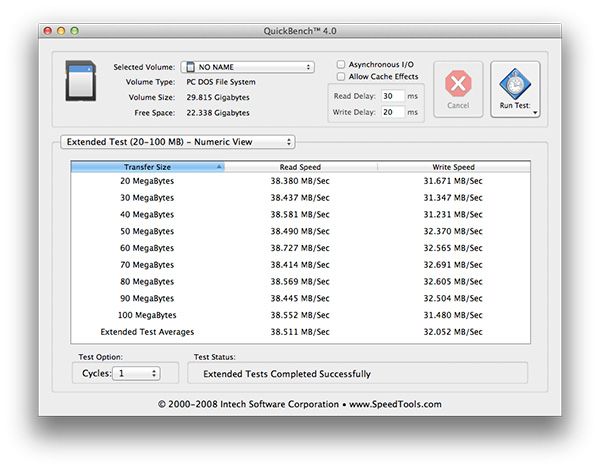
The rMBP by comparison can deliver more than 80MB/s in the read portion of this test. Even writes are faster at ~40MB/s on the rMBP compared to around 32MB/s here. It's a lot of these little things that contribute to the differences between Apple's MacBook Air and Pro lines.
WiFi Performance
Wireless connectivity remains unchanged from last year's model. Broadcom is on 802.11n WiFi duty with its BCM4322. Both 2.4GHz and 5GHz bands are supported. The same 2x2:2 configuration (2 send and receive antennas with 2 spatial streams) remains from last year as well.

I ran the 13-inch MacBook Air through the same three location WiFi test that I put the rMBP and 2011 MBP through, on both 5GHz and 2.4GHz. Performance on 2.4GHz was unusually low on the Netgear WNDR4500 I usually test with (10 - 20Mbps regardless of location) so I had to switch to the previous generation Apple Time Capsule to ensure there was nothing wrong with the notebook itself. All of the 2.4GHz MBA numbers have a star next to them to indicate that they aren't totally comparable as they're using a different AP. The 5GHz numbers all came from the Netgear however.
| Location 1 | Location 2 | Location 3 | |
| 2011 MacBook Pro (2.4GHz) | 124.0 Mbps | 12.6 Mbps | 61.6 Mbps |
| Retina MacBook Pro (2.4GHz) | 117.9 Mbps | 87.6 Mbps | 44.0 Mbps |
| 2012 MacBook Air (2.4GHz) | 95.7 Mbps* | 75.2 Mbps* | 31.2 Mbps* |
| 2011 MacBook Pro (5GHz) | 186.8 Mbps | 154.6 Mbps | 24.7 Mbps |
| Retina MacBook Pro (5GHz) | 227.7 Mbps | 156.8 Mbps | 33.7 Mbps |
| 2012 MacBook Air (5GHz) | 159.4 Mbps | 97.0 Mbps | - |
Overall WiFi performance is decent but obviously not as good as what you get from a MacBook Pro. Looking back at the results I almost wonder if the 2011 MBP wasn't showing some of these weird 2.4GHz issues on the Netgear router as well.
In the best conditions on 5GHz you can hit around 160Mbps, but you pretty much have to be right next to a good AP for that to work. Across a large room or in an adjacent one just under 100Mbps is possible on 5GHz as well. Go further out and you'll have to switch over to 2.4GHz.
There are no wired network options by default, however Apple's Thunderbolt to Gigabit Ethernet adapter works just fine on the new Air as well as the rMBP.
MagSafe 2
MagSafe 2 makes an appearance on the new MacBook Air, although it's curiously absent from the non-retina MacBook Pro. Eventually I'd expect all Macs to use MagSafe 2. The current state of things is likely temporary fragmentation. Similar to the rMBP, the actual power adapters themselves haven't changed: 45W is all you need for both systems.
Ivy Bridge on Air
Apple keeps its CPU options pretty simple and straightforward. You get a choice of three different CPUs, all dual-core, all rated at a 17W TDP. The Core i5-3317U comes standard in the 11, the i5-3427U comes with the 13, and both systems can be upgraded to the Core i7-3667U.
The breakdown between the chips is below:
| Apple 2012 MacBook Air Comparison | |||||
| 1.7GHz dual-core | 1.8GHz dual-core | 2.0GHz dual-core | |||
| Standard On | 11-inch MBA | 13-inch MBA | Optional for Both | ||
| Intel Model | Core i5-3317U | Core i5-3427U | Core i7-3667U | ||
| Base Clock Speed | 1.7GHz | 1.8GHz | 2.0GHz | ||
| Max SC Turbo | 2.6GHz | 2.8GHz | 3.2GHz | ||
| Max DC Turbo | 2.4GHz | 2.6GHz | 3.0GHz | ||
| L3 Cache | 3MB | 3MB | 4MB | ||
| AES-NI | Yes | Yes | Yes | ||
| VT-x | Yes | Yes | Yes | ||
| VT-d | Yes | Yes | Yes | ||
| TDP | 17W | 17W | 17W | ||
| Processor Graphics | Intel HD 4000 | Intel HD 4000 | Intel HD 4000 | ||
| GPU Clock (Base/Max) | 350/1050MHz | 350/1150MHz | 350/1150MHz | ||
The Core i7 upgrade is likely worth it if this is going to be your primary system for an extended period of time, particularly if it's acting as a desktop replacement. As a mobile device the standard CPUs are quite fast. If you're an annual upgrader, save your money, but if you're going to hold onto the system for a while and do a lot of heavy work on it, the upgraded CPU is probably worth it.
There is a known bug with the upgraded CPU under Windows today. Turbo Boost is disabled under Windows on the 3667U, although it's fully functional under OS X. Apple is aware of the problem and I'd expect a fix at some point, but there's no indication of when.


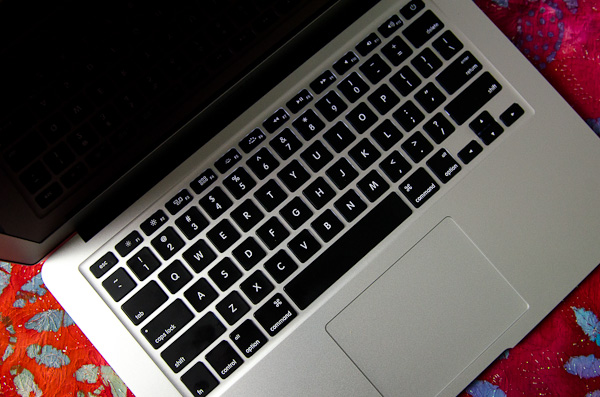
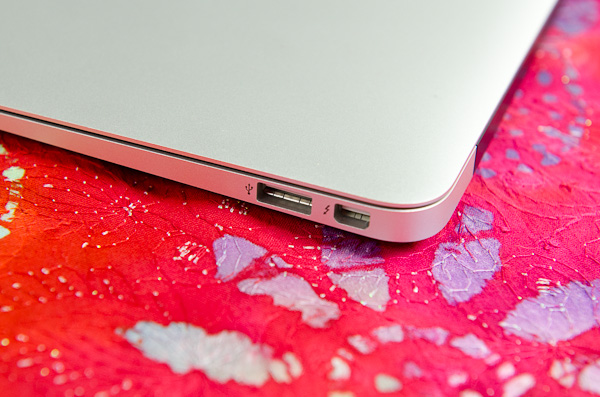

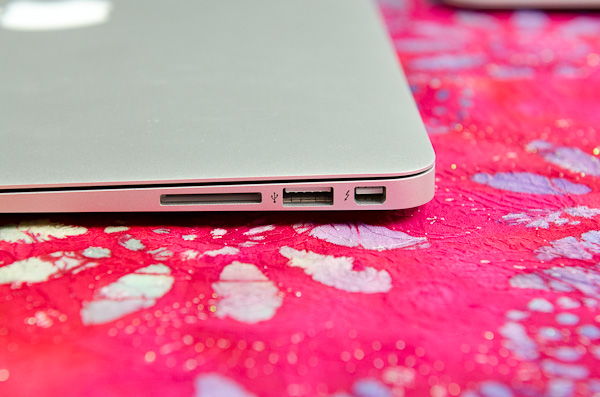
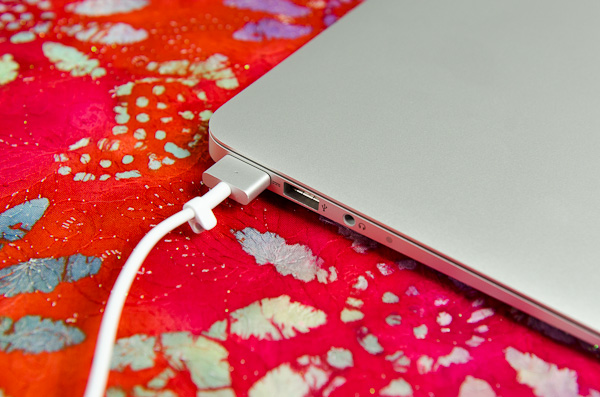








190 Comments
View All Comments
G3t/All - Monday, July 16, 2012 - link
If by games you mean very light duty stuff then yes. It uses an Intel HD4000 graphics chip which translates into no discrete graphics card. This is intended for mobility and not gaming performance. As far as driver problems, you can download all the windows 7 drivers from Apple, or they are included using "Boot Camp". Can't remember which. Driver issues are not the problem, the lack of a discrete graphics card is. Google whatever games your planning on playing and see what kind of framerate they return running on Intel HD4000 graphics. If those numbers are acceptable, then you should be fine.khimera2000 - Monday, July 16, 2012 - link
I avoid Intel as much as possible for gaming. Yes there graphic hardware might be improving, but I hate the bugs. Optimus never worked right on my notebook, my older notebooks always bugged out with dedicated Intel, or some other issue would creep out of the wood work.Your not getting a MacBook air for gaming, ya there's Steam but the thought of gaming on a system like this is in fifth place behind Productivity, Portability, Battery Life, and Build quality. I would go for the Pro with a dedicated Video if your prioritizing anything 3D (games or otherwise.)
KPOM - Monday, July 16, 2012 - link
Be aware of the "bug" affecting the Core i7 models. There is a workaround for the CPU (install a program called ThrottleStop 5.00 beta), but it also seems to have some impact on the GPU right now. Apple is working on a fix, but hasn't said when it will be out.KPOM - Monday, July 16, 2012 - link
The bug is that it doesn't fully enable turbo boost. The i7 is supposed to go up to 3.2GHz, but seems to be topping out around 2.4GHz.KPOM - Monday, July 16, 2012 - link
And note it is only on Windows (Turbo Boost works fine on OS X).ananduser - Monday, July 16, 2012 - link
Yes you will, but windows on a mac incurs some penalties to the battery life and overall performance of the system. Too bad Apple forces you to deal with bootcamp.CharonPDX - Monday, July 16, 2012 - link
"With the 13-inch MBA significantly outpacing even the rMBP with its 95Wh battery, while doing the exact same amount of work."I have to disagree. The MBA isn't doing the same amount of "work", it is performing under a similar effective "load".
Something tells me that if you were performing a fixed amount of work via heavily CPU/GPU-intensive tasks on both the 13" Air and the rMBP, the rMBP would get a lot more of that work done before its battery died than the Air would, even though the Air would run longer. (Say, transcoding twenty hours of HD footage using a transcoder that uses all CPU cores plus the GPU - those four cores and discrete GPU would get a lot more of that twenty hours done than the dual cores with integrated GPU.)
Karltheghost - Monday, July 16, 2012 - link
The Macbook Air is supposed to be an ultraportable, hence to be carried around the whole day. Can it stand a rough use? Since this is an ability that most new notebooks lack, i'm still stuck with my old IBM. You can close the lid, wreck a car using the Tinkpad as a club, open it again and continue working. But does the MBA work after you drop it of the table, for example?tipoo - Monday, July 16, 2012 - link
The aluminium is pretty dent prone, I've seen lots of nasty dings in aluminium macs. If the dent is deep enough it could damage something vital. The SSD does help with durability though since there are no moving heads and spinning platters to crash.GotThumbs - Monday, July 16, 2012 - link
Over the 9+ years that I've been visiting AnandTech, I've never felt more disappointed. This "Review" (reads more like a paid endorsement) lacks a sense of independent subjectivity and over flows with Fanboism.I'm really disappointed in this read.
" tons of power plus upgradability" (New technical term..."tons")
" It was a bold move but one that was very forward looking."
" If Apple were to do the Retina treatment on here, it'd be magnificent."
" If carrying anything larger than a tablet upsets you, buy the 11."
"The new 11-inch model would start at just $999. And the 13-inch would only cost $300 more. The very first MacBook Air, by comparison, retailed for $1800"
Anyone with a brain knows that by Apple using its existing parts bins (the case and what ever else) over 3 years and factoring the scale of economics....the cost was overdue for being dropped. (although 999 is not a price drop from 999 for the 11") It's only that Apple is now experiencing competition to its existing limited product pool, that it's decided to "lower" the cost of its products. Still, how much does Apple charge for a memory upgrade, compared to the cost of upgrading any PC these days? The cost of consumer SSD's had dropped, yet how much does apple upgrade cost? Apple has and continues to overcharge when doing a spec to spec comparison.
In the past I recognized that Anand was careful to remain impartial and fair is His reviews and commentaries.....Today He has failed to do so and It has just weakened the foundation of this sites independence and impartiality in the computer industry. At least for me it has.
Very disappointed Anand. Very disappointed with you.